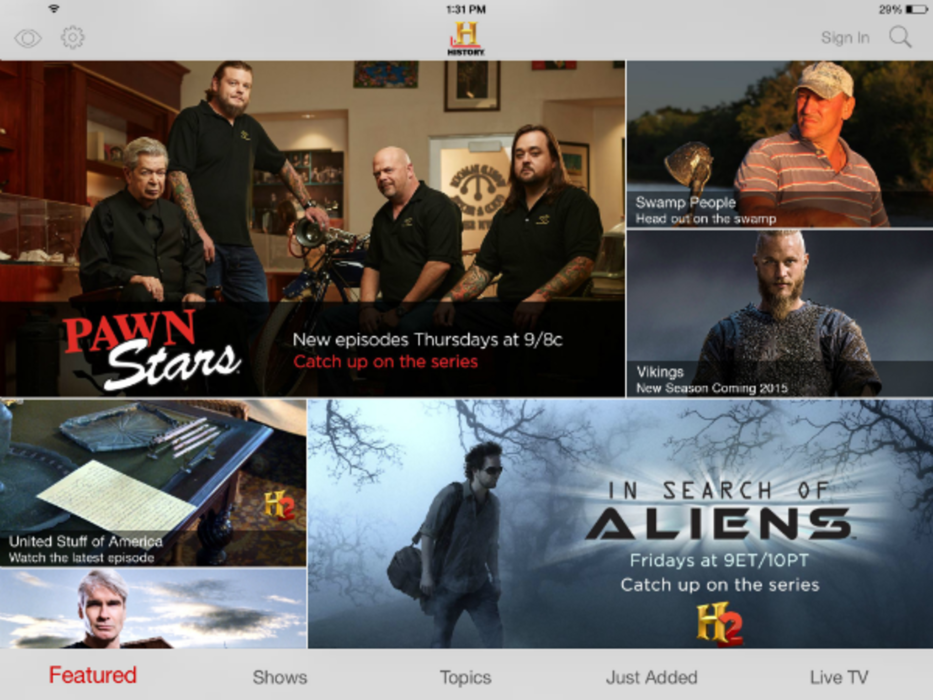Figuring out how to use push notifications to deliver relevance—instead of annoyance—can be a real saga for marketers. To avoid this drama, entertainment media company A+E Networks began sending targeted push notifications based on behaviors. This helps the network drive audiences back to its mobile app and TV channels.
The premiere
A+E implemented Localytics‘ marketing and analytics platform to enable the segmentation that guided the behavior-based notifications. The network first implemented Localytics’ platform in December 2011 to better understand user engagement on its “TV everywhere” apps, which offer full episodes of network shows and short-form content, says Lee Boykoff, VP of digital analytics and CRM for A+E. The company offers these in-app experiences for its A&E, FYI, HISTORY, and Lifetime networks. In January 2014 A+E adopted another Localytics tool, which enables the network to segment audiences based on in-app behaviors so it can send more relevant, targeted push notifications.
Although the brand had been sending push notifications since it first launched its apps several years ago, its previous vendor didn’t allow for sophisticated segmentation, Boykoff explains. Today, A+E follows what Anju Aggarwal, global director of product marketing at Localytics, describes as an understand-segment-target-and-iterate framework.
The plot (and the data) thickens
First, A+E uses Localytics’ platform to analyze in-app behaviors. This includes monitoring the type of content users consume, their flow, as well as their retention rates, Aggarwal says. A+E then takes this behavioral data and combines it with demographic and device data to segment its audiences. Once the audiences are sliced and diced, A+E sends each group targeted push notifications based on their implied interests. So if the company detects that a user consumes a lot of Pawn Stars content, A+E can alert him when a new episode becomes available on the app, Boykoff says. iOS users have to opt in to receive these messages while Android users automatically receive them based on default settings. Subsequently, A+E can use Localytics’ A/B testing and measurement tools to test and tweak its messages.
“It’s a targeted way to approach the audience so that we’re not broadcasting messages that are less relevant to folks and that we’re really homing in on their specific interest,” Boykoff adds.
Engaging audiences
The push notifications always drive users back to the app, but the media company also occasionally uses the notifications to guide users back to the television, says Jen Taylor, director of digital audience development at A+E. When A+E launched its Lifetime movie The Unauthorized Story of Saved by the Bell, for instance, the network sent push notifications to its original-movie fans reminding them to tune in to the premier that evening and to check out a five-minute preview of the film via the app, Boykoff says.
Boykoff notes that A+E tries to tailor the tone and language of its messages to each show’s audience. For example, A+E knows that the viewers of FYI, its lifestyle program network, tend to skew a bit younger, so the push notifications read more colloquial than the messages sent to A+E’s HISTORY viewers, who are typically older, conservative males, Boykoff says.
“It’s dangerous to assume that all people who use your app have the same profile,” Boykoff says. “Certain people are using the app for different reasons.”
Critics’ reviews
A+E has seen a 200% increase in push notification engagement, defined as clicks to open the messages, since it started segmenting and targeting its app users. (Although A+E can use Localytics’ platform to measure whether message receivers returned to the app, it can’t track whether the notifications caused them to tune into the TV.)
Another benefit of the targeted messaging has been the wealth of knowledge A+E has obtained by tracking trends among its app users. One point of interest, Taylor says, is that the media company’s most popular shows on television are also the most consumed shows on the app. Additionally, shows with younger audiences—like Dance Moms—tend to have larger audiences on mobile, Boykoff says. A+E uses the insight, he says, to enhance its other marketing content, such as email campaigns.
A growing series
Because of its success with push notifications, A+E is bringing them back for another season and looking to improve. Boykoff says that A+E would like to tap into some of the techniques that it uses for email. For example, he says he’d like to segment audiences by lifecycle stage in addition to behavior, and then send notifications linked to those stages, such as welcome and win-back messages.
However, Boykoff says, there’s one major difference between the two forms of communication: Push notifications have a much smaller time frame for engagement. “We believe that when we send out a push notification, if it’s not read within a few minutes, it’s unlikely to be read at all,” he says.
This insight helped A+E adjust the timing of its push notifications. In the past A+E would send push notifications the morning after a show aired to alert users that the episode was now available in the app. But after detecting a peak engagement window between 8 p.m. and 12 a.m. Eastern Standard Time, A+E started sending more messages around 7:45 pm.
“We’re always looking to improve,” Boykoff says. “You never arrive at the finish line when it comes to the user experience and driving engagement.” Looks like viewers will just have to stay tuned to see what A+E rolls out next.








